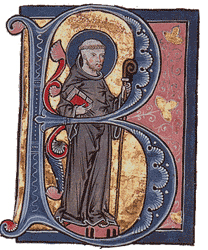(Sacer) Ordo Cisterciensis | |
 Coat of arms of the Cistercians | |
| Abbreviation | OCist or SOCist |
|---|---|
| Formation | 1098 |
| Founder | Bernard of Clairvaux; Robert of Molesme, Stephen Harding, and Alberic of Cîteaux |
| Founded at | Cîteaux Abbey |
| Type | Catholic religious order |
| Headquarters | Piazza del Tempio di Diana, 14 Rome, Italy |
Abbot General | Mauro-Giuseppe Lepori |
Parent organization | Catholic Church |
| Website | www |


The Cistercians (/sɪˈstɜːrʃənz/), officially the Order of Cistercians (Latin: (Sacer) Ordo Cisterciensis, abbreviated as OCist or SOCist), are a Catholic religious order of monks and nuns that branched off from the Benedictines and follow the Rule of Saint Benedict, as well as the contributions of the highly-influential Bernard of Clairvaux, known as the Latin Rule. They are also known as Bernardines, after Saint Bernard, or as White Monks, in reference to the colour of their cowl, as opposed to the black cowl worn by Benedictines.
The term Cistercian derives from Cistercium, the Latin name for the locale of Cîteaux, near Dijon in eastern France. It was here that a group of Benedictine monks from the monastery of Molesme founded Cîteaux Abbey in 1098. The first three abbots were Robert of Molesme, Alberic of Cîteaux and Stephen Harding. Bernard helped launch a new era when he entered the monastery in the early 1110s with 30 companions. By the end of the 12th century, the order had spread throughout most of Europe.
The keynote of Cistercian life was a return to literal observance of the Benedictine Rule. The reform-minded monks tried to live monastic life as they thought it had been in Benedict's time; at various points they went beyond it in austerity. They returned to manual labour, especially agricultural work in the fields. The Cistercians made major contributions to culture and technology: Cistercian architecture has been recognized as a notable form of medieval architecture, and the Cistercians were the main force of technological diffusion in fields such as agriculture and hydraulic engineering.
Over the centuries, education and scholarship came to dominate the life of many monasteries. A reform movement seeking a simpler lifestyle began in 17th-century France at La Trappe Abbey, and became known as the Trappists. They were eventually consolidated in 1892 into a new order called the Order of Cistercians of the Strict Observance, abbreviated as OCSO. The Cistercians who remained within the Order of Cistercians are called the Cistercians of the Common Observance (OCist).